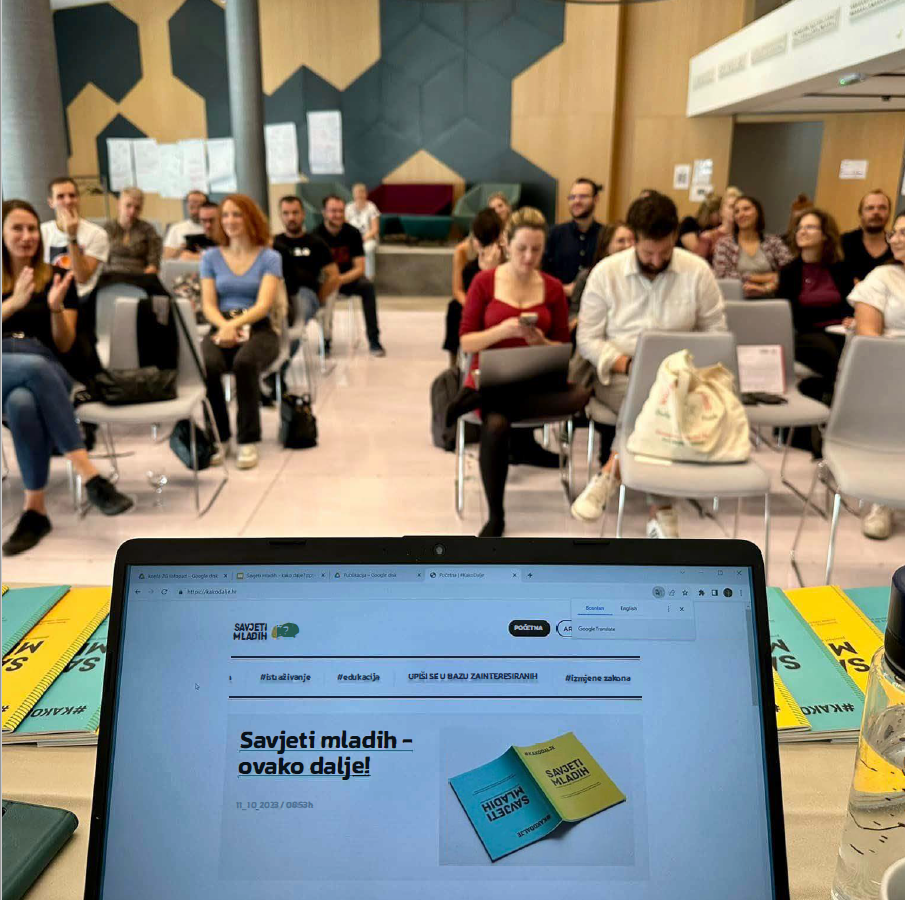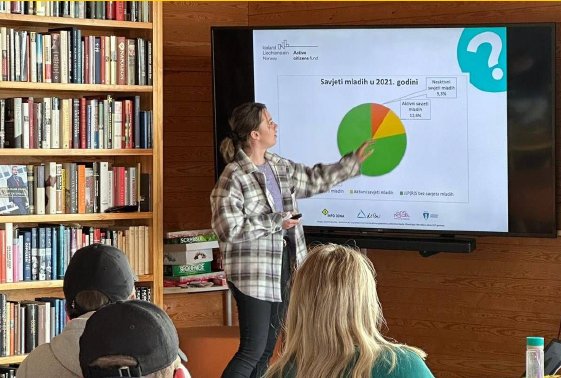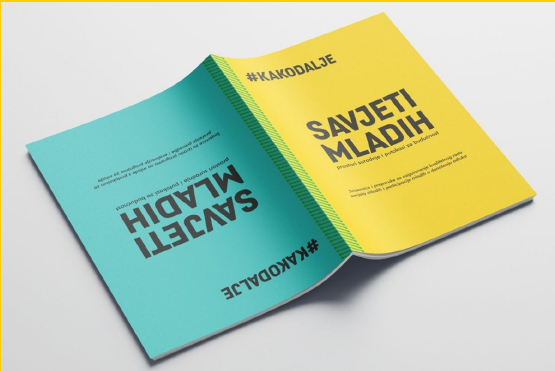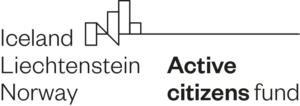Youth Councils – What’s Next?
Posted 26.01.2024.

Youth councils in Croatia play a crucial role in empowering young people and integrating them into local and regional decision-making processes. However, despite the existence of a legal framework, their implementation often faces challenges – from a lack of interest among decision-makers to the absence of clear mechanisms for monitoring their work. These challenges were the focus of the project “Youth Councils – What’s Next?” implemented by Info zona in partnership with other organizations, with the support of the Active Citizens Fund in Croatia.
The project aimed to analyze the current state and needs of youth councils in Croatia, strengthen their work, and enhance youth participation in decision-making processes. Through research, advocacy activities, and the development of tools for more effective youth council operations, the project laid the foundation for long-term improvements in how young people engage in decision-making.

Key Project Outcomes
During the project, guidelines and recommendations were developed to ensure the effective functioning of youth councils, compiled in the publication “Youth Councils – Spaces for Collaboration and Roadmaps for the Future.” In the first few months after its release, the publication was downloaded over 100 times, and printed copies were distributed to relevant stakeholders.
The project also included a participatory research that surveyed 146 representatives of local and regional self-government units and 118 former and current youth council members. These numbers exceeded initial expectations, demonstrating significant interest and the need to improve youth council operations.
In addition to research activities, meetings were held with decision-makers, including representatives of the Central State Office for Demography and Youth. Through advocacy efforts, project partners participated in public consultations on amendments to the Law on Youth Councils, submitting over 30 proposals, some of which were accepted.
Meeting Held with the Central State Office for Demography and Youth
(24.02.2023.) The main topics of the meeting were the involvement of young people in decision-making processes, the ongoing amendments to the Law on Youth Councils, and the preliminary findings of the research on youth councils.
Representatives of the Central State Office for Demography and Youth, as well as representatives of organizations implementing the project “Youth Councils – What’s Next?”, held an online meeting to discuss the participation of young people in decision-making processes, current amendments to the Law on Youth Councils, and the initial research results.
The meeting highlighted that, according to the research findings, youth councils often engage in activities that do not align with their scope, purpose, and objectives, while also spending significant public funds on such activities. An analysis of 169 activities from 13 youth council programs across Croatia revealed that nearly 40% of the total budget allocated to youth councils is spent on activities unrelated to their intended purpose. Specifically, €20,024.58 out of a total of €53,434.32 across nine analyzed financial plans was spent on activities that do not align with the statutory purpose of youth councils.
Comparing the total number of analyzed activities (169) with those that fit within the defined purpose and scope of youth councils (111) or those that explicitly comply with the mandatory activities outlined in Article 19 of the Law on Youth Councils (67), the data shows a significant discrepancy between the activities carried out by youth councils and their legally prescribed functions.
At the same time, preliminary research findings on the needs of local and regional self-government units (JLP(R)S) in working with youth councils indicate that JLP(R)S representatives require support in creating a motivating environment for youth councils and/or acquiring skills to better understand and address factors contributing to low motivation among youth council members (23.32%, N=78). These insights were derived from surveys conducted among 194 representatives of JLP(R)S units and 200 youth council members, which began during last year’s National Conference of Youth Councils of the Republic of Croatia in Šibenik.
In the next phase of the “Youth Councils – What’s Next?” project, tools will be developed to monitor the implementation of the Law, along with educational materials containing guidelines and recommendations for ensuring the quality work of youth councils and enhancing youth participation in decision-making. Additionally, a collaboration with the Central State Office for Demography and Youth has been established to develop a Template for the Development of Youth Council Work Programs.
Source: kakodalje.hr
Challenges and Lessons Learned
One of the key challenges encountered during the project was the lack of systematic monitoring of youth councils and the inconsistent practices across different regions of Croatia. While some youth councils exist only on paper, others are active but struggle with limited resources and support. Additionally, young people often lack awareness of the opportunities available to them through youth councils, further complicating their functionality.
The project highlighted the need to increase awareness of the importance of youth participation and to strengthen local government units in effectively implementing legal frameworks.
Presentation of Research Findings and a Guide for Youth Participation in Advisory Bodies
(October 16, 2023) – On Friday, the final event of the project “Youth Councils – What’s Next?” took place in Zagreb and via the online Zoom platform. The project aims to strengthen meaningful youth participation in advisory bodies at county, city, and municipal levels. Among the 50 participants, the majority were representatives of civil society organizations and youth councils, while local and regional government representatives, as well as other interested stakeholders, joined online.
In the introductory part, Goran Biličić from Info zona presented the project activities carried out over the past 13 months. He highlighted the project’s contributions to the process of amending the Law on Youth Councils, noting that project partners submitted dozens of proposals and comments during public consultations, some of which were accepted. He also emphasized the successful collaboration with the Central State Office for Demography and Youth in developing a template for drafting youth council work programs. The program continued with discussions on best practices from Norway, the importance of the conducted research, and the newly developed guide.
Norwegian Model: Every Municipal Council Meeting Starts with a Youth Speech
Antonia Kuzmanić from Info zona shared insights into youth participation practices from the project’s Norwegian partners. Alongside project representatives, the study visit to the Norwegian municipality of Lindesnes included members of the Youth Council of the City of Osijek and representatives from the youth councils of Pazin and Trogir. Comparing Croatian and Norwegian practices, Antonia pointed out key differences. One notable distinction is that in Norway, individuals cease to be members of the Youth Council at the age of 19, as they become eligible to vote and run for all political bodies. It is believed that at that point, there is no longer a need for them to act through a Youth Council.
A particularly well-received practice from Norwegian partners is the tradition that every municipal council meeting begins with a speech by a Youth Council representative. In a five-minute address, young people can present current youth-related issues directly to council members.
Research Findings: Almost 40% of Youth Council Budgets Spent Unjustifiably
Presenting the research findings, Maša Cek from Udruga Delta outlined key conclusions. She explained the research methodology, emphasizing that the target group was involved in the research preparation. The analysis included 13 youth council work programs, while nearly 400 youth council members and municipal administration employees completed a survey. Additionally, 20 members from 17 youth councils participated in focus groups.
The research revealed an alarming statistic: nearly 40% of youth council budget funds are spent on activities outside their designated scope. Another concerning finding is that 70% of public administration employees have not received any training on working with youth councils. The full research report is available for download.
New Guide: “Youth Councils – Spaces for Collaboration and Roadmaps for the Future”
At the end of the two-hour event, Sara Sušanj from Udruga Delta presented the newly published guide, “Youth Councils – Spaces for Collaboration and Roadmaps for the Future.” The need for such a resource was highlighted by research findings and the positive reactions of event participants. The guide, spanning 60 pages, is divided into two main sections. The first part offers guidelines and recommendations for ensuring the quality of youth councils and youth participation in decision-making. The second section provides instructions for developing youth programs, including protocols for monitoring and evaluating their implementation. Interested individuals can download a digital version of the guide for free or request a printed copy. Those seeking online consultations on the guide’s content can contact antonia@infozona.hr (Source: kakodalje.hr)

Long-term Impact and Next Steps
Thanks to this project, concrete tools have been created that will provide long-term benefits for youth councils, youth organizations, and decision-makers. Furthermore, the project team has already initiated follow-up activities through an Erasmus+ project that will focus on further strengthening youth participation.
Youth councils can and should serve as a bridge between young people and institutions, but to achieve this, they need strong support, systematic monitoring, and effective tools. The “Youth Councils – What’s Next?” project has made a significant step in this direction, but the fight for meaningful youth inclusion in decision-making has only just begun.
